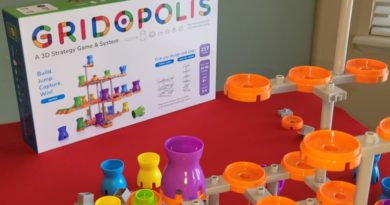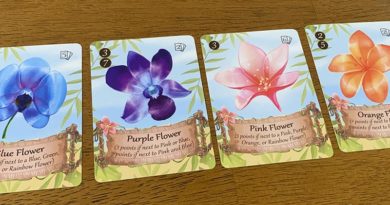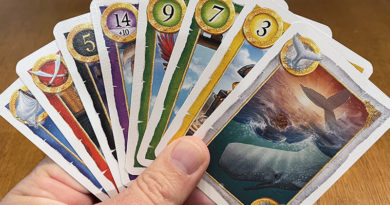The Quest for El Dorado board game review

Deep in the jungles of South America lies the famed city of gold – El Dorado. Unlimited treasure awaits the explorer who first sets foot on this hidden kingdom.
And it could all be yours!
If you’re the first to reach it…
In The Quest for El Dorado by Ravensburger players traverse jungle, waterways, and native villages to find the elusive treasure. They must prepare well to make the journey. But they can’t spend all their time preparing or they’ll be left behind and another explorer will beat them to it.
How will you do on this quest?
How to play The Quest for El Dorado
The Quest for El Dorado is a deck-building game with an adventure board to race across. The objective is to be the first player to get their explorer to the famed El Dorado tile at the end of the jungle.
Players start the game with 8 cards and use those cards to move through various terrain spaces as well as purchase additional (and more powerful) cards to add to their personal deck.

Set up:
To set up the game, players first decide on the map they want to traverse to El Dorado. There are numerous illustrated map layouts players can choose from or create their own using the double-sided map tiles. Where the large map tiles connect, players place a random Blockade tile.
Each player receives their colored playing piece and set of starting cards with that color icon in the bottom right corner. The starting cards are 1 Sailor, 3 Explorers, and 4 Travelers. Players shuffle their personal deck and draw 4 cards to their hand.
Lastly the marketplace is prepared. Players sort the card by type (there are 3 cards of each type) and place them in stacks in the marketplace. Those with a circle icon in the bottom right corner are placed on the market board. These are the first types of cards that can be purchased from the marketplace. The other piles of cards are placed above the board and will be placed into the available spots on the market board during play.

Player Turns:
On a player’s turn they can play all cards from their hand or keep some in hand for their next turn.
When playing cards, a player first plays cards used for movement. Each hex space on the board shows the type requirement to move onto it (machete, paddle, or coin) as well as the amount (“power”). The power value on the card must be equal or higher than the power on the hex.
If a player has “leftover” power, they may use it to continue moving. However, cards can not be combined to move onto a space.
For example, a Machete card with power of 2 can be used to move onto a hex with 1 machete and then move again onto a space with 1 machete. But two cards with a power of 1 each may not be combined to move onto a hex showing 2 machetes.

Some grey spaces on the board allow players to discard cards of any type to move onto them. And red Base Camp spaces allow players to remove cards from the game.
Players can not move onto mountain hexes or onto spaces occupied by other playing pieces.
The first player who wants to cross a Blockade must overcome it by playing associated movement cards. That player then removes the Blockade tile and keeps it. These will be used as a tie-breaker at the end of the game if necessary.
After the moving step, players can buy 1 card from the marketplace. Cards with a coin symbol are worth their power in the marketplace. All other cards are worth 1/2 coin each. Only cards on the market board may be purchased. And purchased cards immediately go to that player’s discard pile.
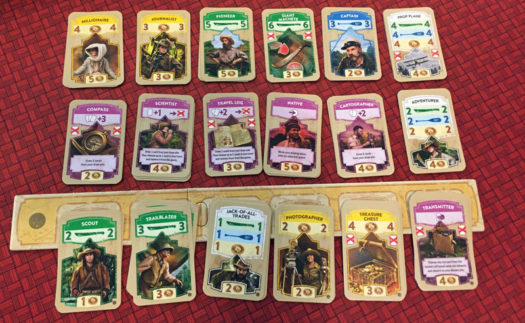
If there’s an empty space on the market board, the active player may choose a card from any of the other piles above the market board they can afford. Once chosen, the remaining cards of that type are then placed on the market board to fill the empty space. Now those are available for all players to purchase on future turns.
The starting cards in a player’s deck are all a power level 1. Cards that become available in the marketplace include higher power cards for bigger movement through jungle, rivers, and villages. Other cards include special actions such as drawing extra cards, getting a free card, ignoring space requirements, or purging cards from the game.
A player ends their turn by moving all played cards to their discard pile and drawing more cards from their deck until they have 4 cards in hand. If there aren’t more cards to draw, the player shuffles their discard pile and it becomes their new draw pile.

Game End:
When a player reaches one of the 3 finishing spaces at El Dorado, this triggers the final round of the game. Each player left in that round will now play their final turn.
Once that round is completed, the game is over.
The player who made it to El Dorado is the winner!
If more than 1 player made it to El Dorado, the player who has collected the most Blockades wins the game.

Cave Variation:
Players can also choose to explore caves in the mountains along their path to El Dorado.
During set up, players shuffle the 36 cave tokens and then place stacks of 4 cave face down cave tiles on each mountain hex showing a cave icon.
If a player comes to a stop next to a cave, that player explores it. The player takes the top cave token and puts it face up in front of them.
To explore the same cave again, the player must first move away – stopping on a space not adjacent to the cave. Then they can move and stop next to the cave again on a subsequent turn to explore it again.
Cave tokens give additional abilities similar to cards players can purchase, but also include other abilities like moving through occupied spaces or changing symbols on the cards you play.
Once collected, a player may use a cave token any time during their current or future turns. Once played, the cave token is removed from the game.
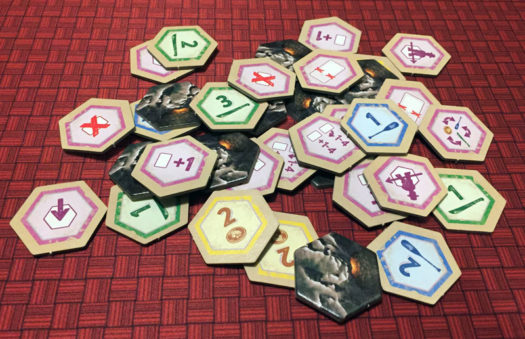
Can the whole family enjoy The Quest for El Dorado?
The Quest for El Dorado was in contention for the Spiel des Jahres family game of the year in 2017 for a reason. While it didn’t win the award (Kingdomino did), we’re sure it was a tough decision because it’s a great game for families.
The simple mechanics and flow of the game will draw in players of all ages. And the reference boards for each player outline the steps of a player’s turn so easily that anyone can join in the fun.
While the game is recommended for players age 10+, that shouldn’t stop you from playing with younger kids in your family. That’s because even younger kids can match colored cards with the colored spaces they must traverse. You’ll need to help them with their first couple turns of managing their hand of cards, but they’ll get the hang of it quickly enough to love playing.

Things we love about The Quest for El Dorado
Ever since we first played Dominion, we’ve been hooked on deck-building games. The strategy of which cards to acquire to build a strong deck and the luck of the draw pull us in for many repeated plays.
Well, in The Quest for El Dorado we get the deck-building aspect mixed with a race across various terrain that changes every game. So while the cards you can purchase to add to your deck may not vary, which cards you acquire will change based on the layout of the terrain each time you play.
And in that way it’s kind of like a puzzle to figure out how to get across the board in the smoothest path.
Of course, those plans may change because of which cards you draw into hand or where the other players traverse (blocking your way). But the ability to hold a card in hand until your next turn is fantastic.
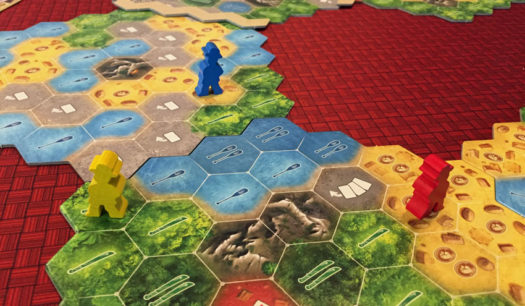
We also love that cards without a coin on them are still worth something when purchasing other cards. The coin cards help get you through villages, but we find they’re most valuable in paying for other card. However, if that was the only way to get new cards, we’d be stuck for much of the game with low powered movement cards.
And getting special power cards deliver a lot of the fun. It’s always exciting when you draw these cards into your hand for your next turn.

The only thing we don’t like is having only 4 cards in hand to use. Of course we want more cards in hand to cruise through the board. But that’s also what makes the special power cards and high powered movement cards so enticing. Our favorites seem to be those that let us draw more cards into our hand.
But in the end we realize the limit of 4 cards per hand is what keeps a bit of racing tension in the game. It’s this limit that keeps us engaged in planning out our next moves.
The other limit is that there’s only 3 cards of each type in the marketplace. So in a 4-player game, someone will be out of luck in getting a certain type of card in their deck. Which means there’s also a race to acquire the best cards. Very cool.

How does The Quest for El Dorado score on our “Let’s Play Again” game meter?
 As you can see, The Quest for El Dorado scores very high in our “let’s play again” game meter.
As you can see, The Quest for El Dorado scores very high in our “let’s play again” game meter.
The endless variety of ways to construct the terrain tiles packs a ton of replay value in the game. Sure the game rules show many suggested ways to build the terrain map, but there’s no reason why you have to stick to those. Making an easier or tougher map is part of the fun.
The game also includes a special way to play with 2 players where each player controls 2 explorers. The cool thing is that this makes the game just as enjoyable to play with 2 players as 4.
We highly recommend getting a copy of The Quest for El Dorado for your family.
We’d like to thank Miniature Market for a review copy of The Quest for El Dorado.



